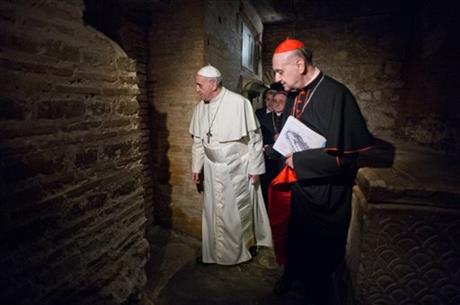
By NICOLE WINFIELD
FILE – In this April 1, 2013 file photo made available by the Vatican newspaper L’Osservatore Romano, Pope Francis, followed by Cardinal Angelo Comastri, right, visits the necropolis where pagans and early Christians were buried under St. Peter’s Basilica at the Vatican and where St. Peter is believed to be buried. The Vatican’s decision to publicly exhibit the purported relics of the Apostle Peter for the first time this weekend has spotlighted the intense scientific debate over whether the bones actually belong to the first bishop of Rome. No Pope has ever definitively declared the bones to be Peter’s, though Pope Paul VI in 1968 said fragments found in the necropolis under St. Peter’s Basilica were “identified in a way that we can consider convincing.” Some Vatican archaeologists disagreed, and debate continues today much as it has over the authenticity of the Shroud of Turin. (AP Photo/L’Osservatore Romano, file, ho)
Vatican St. Peter’s Bones
FILE – In this April 1, 2013 file photo made available by the Vatican newspaper L’Osservatore Romano, Pope Francis kneels in prayer in front of what is believed to be the burial site of St. Peter’s in the necropolis under St. Peter’s Basilica at the Vatican. The Vatican’s decision to publicly exhibit the purported relics of the Apostle Peter for the first time this weekend has spotlighted the intense scientific debate over whether the bones actually belong to the first bishop of Rome. No Pope has ever definitively declared the bones to be Peter’s, though Pope Paul VI in 1968 said fragments found in the necropolis under St. Peter’s Basilica were “identified in a way that we can consider convincing.” Some Vatican archaeologists disagreed, and debate continues today much as it has over the authenticity of the Shroud of Turin. (AP Photo/L’Osservatore Romano, file, ho)
Prev
1 of 2
Next
VATICAN CITY (AP) — The Vatican’s decision to publicly exhibit the purported relics of the Apostle Peter for the first time has spotlighted the intense scientific debate over whether the bones actually belong to the first pope.
Pope Francis on Sunday will preside over a Mass in St. Peter’s Square at which an urn containing the relics will be shown for public veneration. The urn is usually kept in the Apostolic Palace for private veneration by popes, but it will be publicly displayed for the first time to mark the end of the church’s “Year of Faith.”
This is the only such exhibit now planned.
No pontiff has ever definitively declared the bones to be Peter’s, though Pope Paul VI in 1968 said fragments found in the necropolis under St. Peter’s Basilica were “identified in a way that we can consider convincing.”
Some prominent Vatican archaeologists disagreed, and debate continues today much as it has over the authenticity of the Shroud of Turin.
A senior Vatican official, Archbishop Rino Fisichella, acknowledged the debate Monday but suggested it barely matters if scientists eventually determine the bones aren’t Peter’s since Christians have venerated them for two millennia and will continue to do so, regardless.
“We want to highlight the theological value of this,” he told reporters. “Then, correctly, archaeologists will do all their research. And we will be happy if even one day we were to arrive at an even clearer decision from the scientific point of view.”
But he stressed: “We believe. We believe this. Faith, the devotion of the people of God, have always held that these were the relics of the Apostle Peter. And in this way we continue to venerate them and give them the honor they deserve.”
The general public can visit the tomb of St. Peter in the necropolis under the basilica, where Francis prayed in the weeks after he became pope, the first pontiff to visit the tomb.



